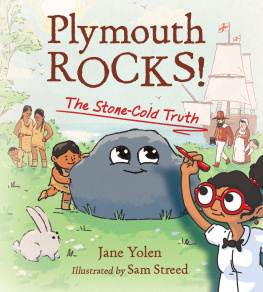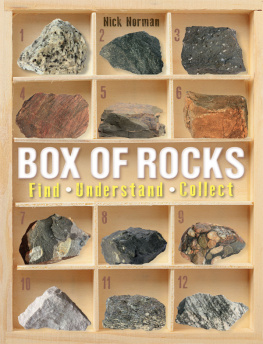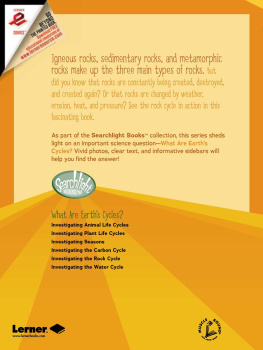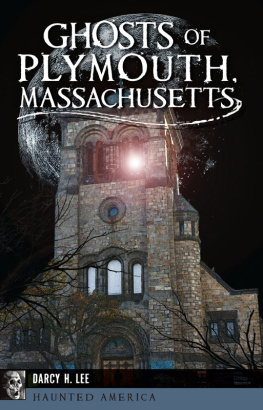To Yo, her bookJ. Y.
For Amelia and LeoS. S.
Text copyright 2020 by Jane Yolen
Illustrations copyright 2020 by Sam Streed
All rights reserved, including the right of reproduction in whole or in part
in any form. Charlesbridge and colophon are registered trademarks of
Charlesbridge Publishing, Inc.
At the time of publication, all URLs printed in this book were accurate and
active. Charlesbridge, the author, and the illustrator are not responsible for
the content or accessibility of any website.
Published by Charlesbridge
9 Galen Street
Watertown, MA 02472
(617) 926-0329
www.charlesbridge.com
Printed in China
(hc) 10 9 8 7 6 5 4 3 2 1
Library of Congress Cataloging-in-Publication Data
Names: Yolen, Jane, author. | Streed, Sam, illustrator.
Title: Plymouth rocks: the stone-cold truth / Jane Yolen; illustrated by Sam
Streed.
Description: Watertown, MA: Charlesbridge, [2020] | Written for the 400th
anniversary of the Pilgrims landing in Massachusetts. | Includes
bibliographical references. | Summary: In humorous verse Plymouth Rock
tells the story of itself, from glacial erratic to national iconwith historical
asides and corrections by a fact checker.
Identifiers: LCCN 2019008772 (print) | LCCN 2019010852 (ebook) | ISBN
9781580896856 (hardcover) | ISBN 9781632898326 (ebook)
Subjects: LCSH: Historic sitesUnited StatesJuvenile fiction. | National
monumentsUnited StatesHistoryJuvenile fiction. | Stories in
rhyme. | Humorous stories. | Plymouth Rock (Plymouth, Mass.)Juvenile
fiction. | Plymouth (Mass.)HistoryJuvenile fiction. | CYAC: Stories in
rhyme. | Plymouth Rock (Plymouth, Mass.)Fiction. Massachusetts
HistoryFiction. | Humorous stories. | LCGFT: Stories i rhyme. |
Humorous fiction.
Classification: LCC PZ8.3.Y76 Pl 2020 (print) | LCC PZ8.3.Y76 (ebook) |
DDC 813.54 [E]dc23
LC record available at https://lccn.loc.gov/2019008772
LC ebook record available at https://lccn.loc.gov/20190108522
Illustrations doodled on paper, scanned, finished, and colored digitally
Display type set in Old Claude by LetterPerfect Design
Text type set in Lazy Vermont by Lazy Dog Foundry
Color separations by Colourscan Print Co Pte Ltd, Singapore
Printed by 1010 Printing International Limited in Huizhou, Guangdong, China
Production supervision by Brian G. Walker
Designed by Diane M. Earley and Sam Streed
Rock Speaks
Y ou know that Im old,
and rather well known.
But everything told
is not set in stone.
Two kinds of history.
Not all of it true.
Not all of it false.
Its now up to you.
Research and study,
discuss, and choose.
Some call it fiction.
Some call it news.
Rock
Stone has a long memory, but memory does not
always speak true. So I will check the facts. If
Rocks statements are misstatements, alternative
facts, fabulations, or just plain lies, my red pen
will let you know.
Fact Checker
Rock & Roll
I was not born where I was found.
In fact I wandered all around.
Erratic, I am sometimes called.
A glacial friend just let me fall,
left me there and moved away.
I havent seen it since that day.
(I really hope that its okay!)
A glacial erratic rock is one that was moved by a glacier.
Plymouth Rock is a granodiorite, a rock similar to granite.
More than six hundred million years ago, Rock was part of a
larger granodiorite that was carried away by a glacier. When
the glacier melted, Rock dropped off and got left behind.
More of that larger granodiorite that Rock came
from has been found forty miles away from Plymouth.
Thats really close in glacial terms! (Not very far
in human terms either . )
Rock never moved this fast.
Most glaciers travel less
than half a mile per year.
Rock Bottom
A few years latereons, they say
woolly mammoths came my way.
Rubbed their tails on my backside.
My, those creatures sure were wide.
Rock almost gets a pass on this one . Woolly mammoths
did come across the Bering Strait to North America.
Though most of their bones have been found in the
Dakotas, a few remains of mammoths have been found
closer to the East Coast.
A couple of mammoth teeth have actually been unearthed
in Cape Cod. So maybe one or two wandered that far?
Or maybe their fossilized bones got dropped by some
kind of erratic rock. We just dont know yet.
Rock Band
F or a long while, just creature comforts:
deer and elk galore.
An occasional snake for shivers sake,
though after a while it, too, proved a bore.
A stones life has but few adventures.
A rock, a rolland little more.
My goodness, Rocks left out a lot!
In addition to the creatures Rock mentions,
there were also wandering raccoons, wolves,
turkeys, rabbits, porcupines, shorebirds, and
the occasional bear looking for a mate.
Rock Solid
N ative people fished nearby me.
Their children sometimes tried to climb me.
Their fires kept me warm and toasty,
cooking dinners that were roasty.
But alas, I do not eat,
and so I never tasted meat.
I am a rock-a-tarian.
Rock is correct on this one. The Indigenous people
of the Eastern Woodlands have inhabited the
area for more than 12,000 years, thousands of years
before the Pilgrims arrived. Back then many tribes,
including Wampanoag, Patuxet, Mohegan, Pequot,
Narragansett, Nauset, and others, lived in the
area. Some of them live there to this day.
Rocking the Boat
N ew men and women passing by
on occasion caught my eye.
Their color, clothes, and tongue seemed strange.
Even a Rock can note that change.
Different people, same old ground.
An old world lost. A new one found.
Rock is missing a lot of detail here.
Settlers didnt just find a new world, they
colonized it. After taking over the southern
part of the East Coast, many English, French,
and Spanish settlers traveled north.
The settlers considered the Americas to be a clean
slate, a New World in which they could create a new
future for themselves. The newcomers thought of Europe
as the Old World and brought over aspects of their
cultures, histories, and religions. The Native people,
however, had lived in the Americas for thousands of
years and did not consider their world new.
The settlers also brought violence and disease,
which dramatically reduced the Native American
population. Much of this started well before
the Mayflower ever set sail.
Stepping Stone
A boat sailed in. The Pilgrims landed.
Its how IRockcame to be branded.
The disembarkers stepped on me,
first footfalls toward their liberty.
I always keep this thought in mind:
What a big step for humankind.
Oh dear! Rock has really gone
overboard! Open the foldout
for the true story.
On November 21, 1620, the Mayflower and its 102
passengers anchored at the tip of what we now
call Cape Cod. Ship's master, Christopher Jones,
took a small group of the colony leaders to explore
the coast. Eventually they found a better harbor,
named Plymouth, and returned to the Mayflower.
The ship sailed to Plymouth, where the
passengers began their new lives.
Plymouth
Better
harbor
The Plymouth landing may have been a big step
for the settlers, but it sure wasnt a positive step for
the indigenous people who already lived there.
No large rock or stepping stone is











